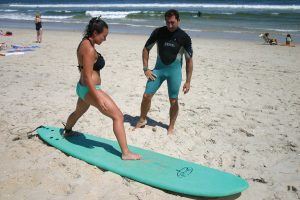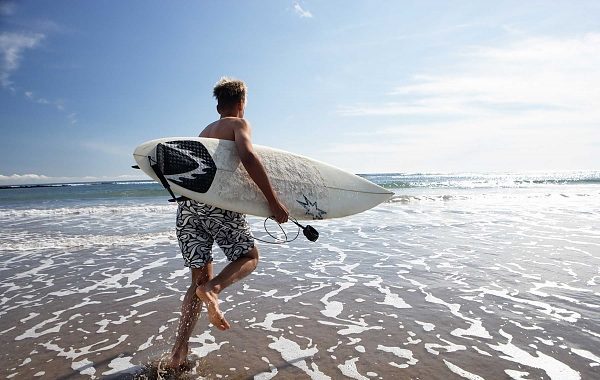Summer may have ended, but experienced surfers know fall is the best time to ride the waves. And where better to learn than the Jersey Shore, which has both world-class waves and great spots to learn. Before diving in to the totally awesome surf scene at the Shore, check out these tips from SJ’s surfing experts.
1. Choose the right board
Beginner surfers are going to want to go for bigger boards, says Dave Werner, an adjunct professor at Stockton University who teaches the course “The Science of Forecasting Waves.” Foam boards are wider and bulkier, which can help new surfers balance, while more advanced surfers will typically choose smaller, thinner fiberglass boards.
“I equate it to driving a Mac truck versus a Ferrari,” says Werner. “You want to start out driving a Mac truck because they’re big and slow. In a Ferrari, you take off with the gas, and you’re going. You’re out of control.” While smaller boards increase maneuverability for skilled surfers, large foam boards make it easier for beginners to catch waves. And no need to buy a board until you’ve tried surfing and feel committed to it – surf shops and instructors will typically have boards available to learn on. Once you do have your own board, you’ve got to take care of it.
“Waxing the board is necessary,” says Werner. “You only wax the top; that’s for grip.”
The type of wax you use – tropical, warm, cool or cold – depends on the water temperature. Wax needs to be scraped off and reapplied any time the season changes or you move to a new temperature. Store a board somewhere dry and cool, like a garage, and not in sunlight or in a hot car where the wax will melt.
Werner advises wearing a wet suit instead of a regular bathing suit in any weather. “I always recommend to the girls to wear some sort of wetsuit top, because the ocean likes to claim clothing,” he laughs. Board shorts and rash guards can protect wet skin from getting irritated on the board. Plus, the warmer you are, the easier it is to learn.
2. Practice makes perfect

Dave Werner explains standing on the board is all about balance
When Lisa Roselli was growing up in Wildwood Crest, she didn’t take surfing lessons – she just grabbed a board and got in the water.
“Everybody taught themselves when we were kids,” she says. “You would have to just go to the beach and watch people. If they were nice, they would help a little bit.”
It’s different now, says Roselli, co-director of the Eastern Surfing Association’s South Jersey District. These days, there are plenty of surf lessons available plus information on the Internet on how to get started.
To get the most from your practice, she recommends keeping the body limber with yoga or Pilates. “Surfing’s a lot of flexibility, so being a muscle man won’t help you,” she says. She compares a surfer’s body to a swimmer’s body – the same shoulder strength swimmers need will help surfers with paddling. Practice paddling in or out of the water. Even if you live inland and can’t get to a beach, Roselli says, grab a surfboard or bogey board and practice paddling in a lake or pool.
3. Watch the water
Waves for surfing, called swell periods, are caused by off-shore weather patterns, explains Werner. “New Jersey has very hit-and-run type swells – here one day, gone the next,” because the weather can change so rapidly. This makes N.J. different from surfing hotspots like California, which have long swell periods, so lots of good surfing weather.
The ocean floor here in New Jersey also has sandbars that are always moving, unlike some beaches with rocky bottoms or reefs. Those beaches, says Werner, “are more predictable. When there’s waves, the waves will break in the same place every single time. In New Jersey, with the sand bottom, it can change from hour to hour depending on where it breaks because of the tide and the wind and the swell.”
But if the tides and the swells line up, it can create great conditions for surfing here. Werner teaches his students how to read long-term swell models, like the ones provided on swellinfo.com and surfline.com, so they can be prepared for when the best waves are coming.
“I can look and see that a good swell is coming Friday, so I know a week in advance I’ve got to get my work done so I can get there,” he says. Fall and winter will usually have the best waves, because hurricanes and nor’easters are brewing out at sea and creating strong swells. Summer, with gentler waves and warm water, is best for learning.
Roselli says some beaches in South Jersey lend themselves to beginners, like the south end of Ocean City, The Cove in Cape May and Nun’s Beach in Stone Harbor. Once surfers are ready to move on to tougher waves, she recommends Long Beach Island, the north end of Ocean City, Atlantic City and Poverty Beach in Cape May. But, Werner cautions, be prepared to follow the waves, depending on the swell direction and the wind. “You can get more time in the water if you know your local conditions,” he says.
4. Go ahead, stand up!
Once you’ve got a spot, time to start surfing. Werner says he sometimes finds beginners have a mental block when it comes to standing up on the board.
“People are scared to make that commitment. But you just have to go for it,” he says. “Once you’re up, you’re going to see it’s not that bad.”
Maintaining balance on the board is paramount, says Werner. The best way to keep stable is to stand with your feet a little more than your shoulder’s width apart. Keep your shoulders and hips parallel with the length of the board, but don’t try to angle your feet – keep them natural, perpendicular to the board. Bend your knees just a bit and relax, says Werner. “You’re basically riding on water with all its bumps and moves – if you’re too stiff, you’ll overreact and fall over. Be loose, yet in control.”
For your first waves, stick to the inside sandbar and look for white-water waves. At first, practice paddling and just riding the waves without standing, adds Roselli. By starting slow you’ll get a feel for what waves are good and when to paddle.
“It’s a major skill to just sit, turn your board while you’re sitting and paddle like crazy for the wave,” she says. And waiting for the perfect wave isn’t a bad place to be: “It’s just so relaxing and quiet. You can bob out there, and see fish and dolphins swimming by. It’s so peaceful.”
5. Wipe out – for real
Once you’re up on the board, you have to come down – somehow. “Surfing is a very contact sport; you’re going to fall a lot, the board is going to hit you a lot,” says Werner. “The key is to learn to fall gracefully.” If you want to dismount, always jump to the side or behind your board, never in front.
Strap a leash to your ankle so you don’t have to go swimming after your board.
“Especially if it’s crowded, don’t let the board get away from you,” Werner says. The leash is important; but be aware that having it on means your board is never far.
“If you wipe out and go underwater and you don’t feel a pull on your leash, then that board is somewhere around your head, within 6 to 8 feet of you,” Werner adds. So whenever you come up, cover your head with your arms. Foam beginner boards are soft, but “if they hit you in the nose, that’s not going to feel good,” he warns.
For good measure, always bring a surfing buddy. “If that board hits you in the head and no one’s around on the beach…” Werner says. “It’s always good to have someone there with you.”
6. Share the sea
It’s smart to be courteous around other surfers, so stay with the easier waves, closer to shore, and let the more experienced surfers go further out with the big waves. When sharing the sea with other surfers, there is an understood etiquette to follow.
“It’s called priority. If there are two surfers going for the same wave, the surfer closest to where the wave is breaking from – or closer to the white water – has the right of way,” says Werner. “If someone else is taking the wave, don’t get in their way.”










